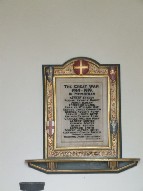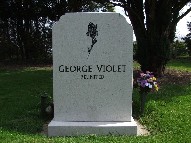| |
|
 |
|
The road between Bury and
Haverhill is one of the worst for
cyclists. Some of the narrower stretches
of it now have a paved footpath at the
side, which is a blessed relief after
miles of playing the ball in a game of
dodge with articulated lorries. One of
the landmarks along the road is this
strangely un-East Anglian church in its
hill-top graveyard. This is obviously an
ancient site, but all around is a
wasteland of factories and business
units. Chedburgh itself is
a pleasant village on the other side of
the road, another mile or so further on.
There's an excellent pub there. I don't
expect too many people regularly walk
along the horrid road to get to the
parish church, and because of this the
church is kept locked, most unusually for
this part of Suffolk. However, there are
three keyholders listed, and this is a
step in the right direction, because when
I last came here about ten years ago
access was impossible. The keys are at
houses in Chedburgh village, but if you
are on a bike or on foot then this
prospect is perhaps not an inviting one.
|
When
I came here before, I could think of almost
nothing to say about this church. I am afraid
that I described it then as a poor and ugly
little church, perhaps because I had found it
unwelcoming, or perhaps the weather had not been
as beautiful as on this spring day in 2008. Now,
I did not see it squat sulkily so much as I had
then, but it looked rather charming and even
fairy tale-like with its strange little spire.
The tower, spire, west end and chancel are all
Victorian; only part of the nave is ancient, late
13th century. The church was rebuilt to the
designs of William Dudley of Bury in 1842.
| I'm fond of observing that a
locked church is a dying church, but it
seems harsh to be too critical of the
community here who find themselves with a
church on the wrong side of a hellish
road. It must be difficult for anyone
without a car, especially in winter. Gazing
through the windows you can see just
about all there is to see, except for
what I understand to be some good modern
glass in the east window. Directly
opposite the south nave windows I could
see the war memorial, and even photograph
it. At first, I took it to be a roll of
honour - how could such a small parish
have lost sixteen of its boys? And yet,
there they were. Five families appear on
the memorial more than once: one, the
Souters, is on there three times. What a
terrible time for a remote, rural
community.
|
|
 |
|
|
|

